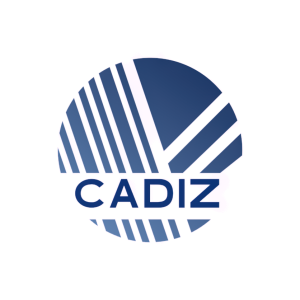Cadiz Issues Shareholder Letter with Lookback on Q1
Rhea-AI Summary
Positive
- Secured 180 miles of steel pipe from Keystone XL project, avoiding 25% tariff increase
- Raised $20 million in equity funding for 2025 development expenses
- Expected reimbursement of $15-20 million in development costs
- Will receive $25 million for NPL assets and $51 million for water storage rights
- ATEC division doubled production capacity with new 20,000 sq ft facility
- 90% win rate on ATEC's water treatment bids with 38% growth in planning stage opportunities
- Potential new revenue streams from hydrogen facilities and data center development at Cadiz Ranch
Negative
- Complex project financing structure involving multiple types of investors causing lengthy due diligence
- Project development costs currently impacting balance sheet until reimbursement
- Delayed permit application submissions due to administration transition
- Post-election chaos and strategic detours affected Q1 progress
News Market Reaction 1 Alert
On the day this news was published, CDZI declined 0.69%, reflecting a mild negative market reaction.
Data tracked by StockTitan Argus on the day of publication.
"Project development is on track; We picked up some strong tailwinds in Q1"
-----
Fellow Shareholders,
In the last six months our team has been at work behind the scenes, navigating the ups, downs and opportunities of the new landscape. Here's a look back on Q1 with an update on key catalysts.
Our overarching goal is to get pipelines built so the Company can begin generating revenues from our water supply and storage assets. We've set an aggressive schedule to complete construction on the Northern Pipeline at the end of 2026 and the Southern Pipeline (for storage) at the end of 2027. Actions taken year-to-date were aimed at keeping us on target for this aggressive timeline.
Our primary objectives in Q1 were to establish the NewCos for project development and secure the lead project investor so we can raise project capital, move development costs off Cadiz' balance sheet, and fund construction. Despite the post-election chaos and some strategic detours, we made substantial progress on all fronts and remain on track to meet our construction timeline.
Highlights from Q1:
Transition – Q1 was dominated by transition in
Tariffs – In December, we closed a deal to purchase 180 miles of steel pipe from the abandoned Keystone XL project. In February, President Trump announced plans to hike tariffs on imported steel by
Permits – Following the election, we delayed submission of permit applications to federal agencies until the new Administration was in place to not lose any momentum in the void of a government transition. In January, following the wildfires in
Investment Tax Credit (ITC) – The election results called into question whether any tax credits for clean energy would be supported by the incoming Congress. Aside from steel, the cost of energy generation was the biggest unknown in terms of project costs. In December, the Company closed a deal to purchase linear generation technology that qualifies for the ITC that expired at the end of 2024. Qualifying for the 2024 ITC provides as much as
Project Finance – Following the election, we made the strategic decision to pivot away from project investors whose funding was tied to the Inflation Reduction Act or other federal climate programs that were expected to be frozen by the Trump Administration. In Q1 we confirmed a lead investor for the project finance company and are in the process of drafting the LLC agreement and related documents for syndication with other project investors. The LLC is a Public - Private Partnership with a complex investment structure due to the number of project investors and diversity of the capital sources involved, which includes private equity, publicly-traded companies, tribal-owned businesses, investor-owned utilities, Opportunity Zone Funds, municipal financing, tax equity and government grant funding. While this is a complex process and the diligence is lengthy, the number and types of investors interested in participating makes this a good problem to have.
To keep us on track, in Q1 the Company closed a
As previously disclosed, in addition to reimbursement of development expenses, the Company also expects to receive payments for the transfer of assets to the LLC in accordance with the terms and conditions set out in the LLC agreement. Expected payments to the Company from the LLC include
Additional Q1 Callouts:
Victor Valley Wastewater Reclamation Authority (VVWRA) whose municipal members include the Cities of
OTHER SEGMENTS:
ATEC
In Q1 ATEC substantially completed delivery on the 60MGD
Interest in ATEC's water filtration technologies for groundwater treatment continues to grow at a robust rate as our presence in the market grows. For context, the groundwater remediation market in the US overall is projected to grow at a CAGR of
For context, remember that we acquired ATEC Systems in 2022 for
ATEC had a surge in inquiries in Q1 after previewing a new water filtration solution for PFAS (forever chemicals) with
Cadiz Ranch
Q1 has been busy at Cadiz Ranch. In addition to preparing for the 2025 growing season, we've been building out the wellfield infrastructure to support construction of the water supply and storage project. We are also assisting RIC Energy with the permit process for development of the hydrogen production facility (announced in Q4 2024) and fielding inquiries from other developers to locate at least one additional hydrogen facility at Cadiz Ranch. In addition, we've received multiple inquiries to locate a data center at Cadiz Ranch as well.
The synergies of co-locating hydrogen, solar and potentially a data center at Cadiz are becoming clear. After we announced the agreement with RIC to build a green hydrogen production at Cadiz, we attracted the attention of other developers looking for space to build data centers. As previously discussed, we intend to develop our land assets to generate the highest value to shareholders and are very encouraged by these recent developments.
Key Takeaways
We understand the importance of continuing to update our shareholders as we work through a complex project financing. We will continue to release as much information as we can, as soon as we can, about our progress on project financing as we finalize agreements with our public and private partners for project finance and reach key milestones. The main message here is that, despite some external chaos, project development is on track; We made strategic decisions that insulated us from variables outside of our control and we picked up some strong tailwinds in Q1.
I look forward to delivering future updates.
Sincerely,
Susan Kennedy
About Cadiz, Inc.
Founded in 1983, Cadiz, Inc. (NASDAQ: CDZI) is a
For more information, please visit https://www.cadizinc.com.
Cautionary Note About Forward-Looking Statements
This investor briefing contains "forward-looking statements" within the meaning of Section 27A of the Securities Act of 1933, as amended (the "Securities Act"), and Section 21E of the Securities Exchange Act of 1934, as amended (the "Exchange Act"), and such forward-looking statements are made pursuant to the safe harbor provisions of the Private Securities Litigation Reform Act of 1995. Forward-looking statements may be identified by the use of words such as "expects," "plans," "intends," "aims," "projects," "believes," "anticipates," "estimates," "targets," "will," "may," "could," "should," "would," "likely," and variations of such words and similar expressions.
These forward-looking statements include, without limitation, statements regarding the Company's expectations concerning the timing, structure, and closing of project financing; the ability to secure commitments from investors and enter into definitive agreements, including the LLC Agreement and the formation of a Joint Powers Authority; expectations regarding the achievement of project development milestones, including the timing of construction and commencement of operations for the Northern Pipeline and Southern Pipeline projects; the anticipated reimbursement of development costs and receipt of asset transfer payments; the potential favorable impact of regulatory, permitting, and political developments, including emergency proclamations; the Company's expectations regarding tax credits and tariff exposure; the expected expansion of ATEC operations and commercialization of new technologies, including PFAS treatment; future development opportunities at Cadiz Ranch; and the overall pace and success of the Company's development and financing activities.
Although the Company believes that the expectations reflected in these forward-looking statements are reasonable as of the date made, there can be no assurance that such expectations will prove to be correct. Actual outcomes and results may differ materially due to a variety of factors, including, without limitation: the ability to negotiate and execute definitive agreements with project investors and partners; delays in construction schedules; delays or setbacks in obtaining required permits and regulatory approvals; changes in applicable laws, regulations, or federal and state policies; the availability and terms of project financing; increases in project costs or adverse shifts in market conditions, including those related to tariffs, inflation, or supply chain disruptions; the ability to further scale ATEC's growth and commercialize its new technologies; and broader political, environmental, or economic developments that may affect the Company's operations, assets, or financing strategy. Additional information regarding factors that may affect the Company's forward-looking statements can be found in the Company's filings with the Securities and Exchange Commission, including its Annual Report on Form 10-K for the fiscal year ended December 31, 2024, and any subsequent filings under the Securities Act and Exchange Act. The Company undertakes no obligation to publicly update or revise any forward-looking statement, whether written or oral, that may be made from time to time, whether as a result of new information, future developments or otherwise, except as required by law.
1 Net proceeds of |
2 https://www.marketsandmarkets.com/Market-Reports/environmental-remediation-market-93290334.html |
![]() View original content to download multimedia:https://www.prnewswire.com/news-releases/cadiz-issues-shareholder-letter-with-lookback-on-q1-302445992.html
View original content to download multimedia:https://www.prnewswire.com/news-releases/cadiz-issues-shareholder-letter-with-lookback-on-q1-302445992.html
SOURCE Cadiz, Inc.









